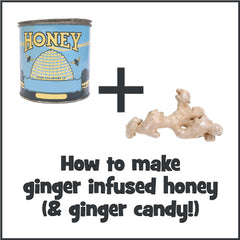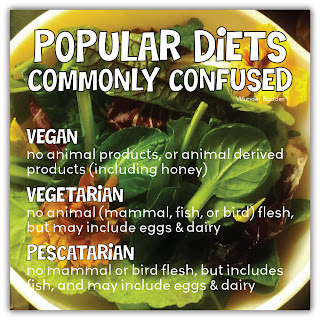
Ginger + Honey = Love.
Honey and ginger do amazing things when they get together. The spiciness of ginger is perfectly calmed with sweet flowing honey, creating a balance of flavor you'll never want to be without again, and after today you'll never have to be. It's very easy to make ginger honey, and the best part? You also end up with spicy ginger candy!
Besides the taste, ginger and honey together are a must-have in your natural prevention of colds/other seasonal illness plans. Both have long been used to prevent colds and aid in a speedy recovery, and ginger is also well-known for relief from nausea caused by motion sickness or excessive gas. Honey can be used to soothe dry throats and ease coughs from scratchy throats, and many people find taking local honey during allergy season relieves their symptoms.
Add ginger honey to your tea, desserts, smoothies, or take a spoonful on it's own. It also makes a great gift!
What you will need
1 cup freshly sliced ginger root
2 cups local raw honey
double boiler or two sauce pans or crockpot
metal strainer (or other heat-resistant strainer)
two clean glass jars with tops (or other air-tight containers)
cookie sheet (or wax paper)
15 minutes prep time, 4 hours minimum (up to 8-12 hours) heating time (Don't be thrown off by the length of time! It can be split up if needed.)
How to make ginger honey
Set up the double boiler. If you don't have a double boiler, you can improvise by using a smaller saucepan resting in a larger saucepan (add water to the bottom pan). You can also use the ring from a canning jar to create a barrier between container and heat, by placing the ring in the bottom of a saucepan, placing a canning jar or glass measuring cup on top of the ring, and adding enough water to cover about an inch or two of the glass. For convenience, you can also use a crockpot. Even on the lowest setting, a crockpot can still be too warm for most herbal preparations, but if this is your only option (or the only option you like), use it.
Take fresh ginger root, and thoroughly wash (scrub it like a potato), leaving peel on. Cut the root thinly, in slices averaging 1/16 inch to 1/8 inch (thinner when cutting a large root, thicker when cutting a small root) until you have about 1 cup. Making herbal food products is rarely an exact science, so don't worry about being exact while slicing or measuring. Add the sliced ginger to the pot.
Measure 2 cups of local raw honey (local is especially important if you are trying to ease seasonal allergy symptoms), and add it to the pot with the ginger.
Turn the stove onto medium low until the water (not the honey!) starts bubbling (light, small bubbles, pre-simmer), then turn it down to the lowest setting. If you're using a crockpot, turn it on to the lowest setting. Cover, and wait. If you're using a jar or measuring cup, lay tin foil over the top, pressing down on the edges just enough for it to stay on (not too tight, there should be some air movement).
The waiting time will vary (see Tips, below), but the honey should warm for at least four hours. Eight to twelve hours is ideal. Keep an eye on the amount of water in the pan and add water as needed.
When the honey is finished, strain into a clean glass jar (a Mason jar, Ball jar, or reused food jar like a glass peanut butter jar) or another heat proof container. Any type of small strainer will do, but metal is the easiest to clean honey from, and a small metal tea or sauce strainer is ideal. One or two layers of cheesecloth can also be used. Leave to cool, then cover.
Spread ginger pieces in a single layer on a baking sheet or a layer of wax paper. Leave to cool, and then put into a small jar or other air-tight container. The ginger candies will harden slightly, but will always remain sticky.
Your ginger honey and candy should be stored in a cool, dark place.
Ginger Infused Honey Tips
Make the honey on a day where you know you will be home for at least four hours, but if you need to split up the process, you may. Leave the honey covered and remove from heat until you can warm it up again.
To decide when the ginger honey is ready, taste a piece of ginger. If the ginger candy tastes too spicy, leave the honey for longer. Test every 1-2 hours. Like stated above, it's not an exact science, so you have freedom to choose how spicy you want the candy to be (the honey can be easily adjusted).
If this ginger infused honey is too strong, add some plain honey to taste and stir well. If you want it stronger, double infuse the honey by straining the ginger candy when ready, putting the honey back in the pot, and adding a new batch of fresh ginger.
As an alternative to heating, you can add all ingredients to a jar and store for a few weeks, but gentle, long heating will give a better result.
Once you get the hang of making infused honey, you can use other herbs and spices to make flavored honey for eating, cooking, or even for natural medicines.
Disclaimer that needs to be added because at some point someone ruined everything for the rest of us: This is for educational purposes only and is not intended to diagnose, treat, cure, or prevent any illness or disease.
XoXo,
Lisa
You may also like...
Lemons for Health!
5 Most Commonly Misused "Natural" Terms
Hidden Animal Ingredients in Food









